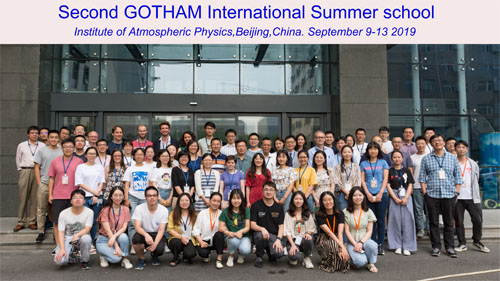The Second GOTHAM summer school was held in Beijing over September 9-13, 2019. This summer school was under the framework of the international research project “Globally Observed Teleconnections and their role and representation in Hierarchies of Atmospheric Models (GOTHAM)”, funded by the Belmont Forum, and was organized and chaired by Dr. WU Bo, Chinese Co-PI of the GOTHAM project. Meanwhile, the summer school was also supported by the State Key Laboratory of Numerical Modeling for Atmospheric Sciences and Geophysical Fluid Dynamics (LASG) and International Partnership Program of Chinese Academy of Sciences “International research project of global monsoons modelling”.
There were 15 lecturer and more than 50 students from a great number of the institutes and universities, including the Institute of the Atmospheric Physics, Nanjing University, Zhejiang University, National University of Defense Technology, National University of Defense Technology, Beijing Normal University, Ocean University of China, Lanzhou University in China, University of Oxford, University of Exeter, University of Reading in United Kingdom, Le Laboratoire de Météorologie Dynamique in France, Potsdam Institute for Climate Impact Research in Germany, Kyoto University in Japan.
The main goal of the GOTHAM summer school was to introduce the basic theories, study approaches and research methods in the global teleconnections, and the progresses of the GOTHAM project. Fifteen lectures covered diverse topics, including the fundamental dynamics of the atmospheric teleconnection, usages of potential vorticity theory over the Tibetan plateau, modulations of the teleconnections on the atmospheric circulations, teleconnection and mid-latitude extreme weather and climate events, teleconnections in the stratospheric process and interactions between the troposphere and stratosphere, teleconnections associated with the air-sea interactions, modulations of the teleconnections on the East Asian climate and others.
In addition to the lectures, the summer school had five hands-on sessions, including Southern Hemisphere SSW in September 2019, ENSO diversity using traditional and network based indices, self-organizing maps, wavenumber/frequency (Hayashi) spectral analysis, and moist static energy budget analysis. The five instructors of these exercises not only talked about the applications of these methods in solving the frontier scientific questions, but also taught the detailed analysis processes and the usages of the related software, which can help the young students to conduct their own studies in the atmospheric teleconnections.

